The Samsung Galaxy S10+ Snapdragon & Exynos Review: Almost Perfect, Yet So Flawed
by Andrei Frumusanu on March 29, 2019 9:00 AM ESTInference Performance: APIs, Where Art Thou?
Having covered the new CPU complexes of both new Exynos and Snapdragon SoCs, up next is the new generation neural processing engines in each chip.
The Snapdragon 855 brings big performance improvements to the table thanks to a doubling of the HVX units inside the Hexagon 690 DSP. The HVX units in the last two generations of Snapdragon chips were the IP blocks who took the brunt of new integer neural network inferencing work, an area the IP is specifically adept at.
The new tensor accelerator inside of the Hexagon 690 was shown off by Qualcomm at the preview event back in January. Unfortunately one of the issues with the new block is that currently it’s only accessible through Qualcomm’s own SDK tools, and currently doesn’t offer acceleration for NNAPI workloads until later in the year with Android Q.
Looking at a compatibility matrix between what kind of different workloads are able to be accelerated by various hardware block in NNAPI reveals are quite sad state of things:
| NNAPI SoC Block Usage Estimates | |||
| SoC \ Model Type | INT8 | FP16 | FP32 |
| Exynos 9820 | GPU | GPU | GPU |
| Exynos 9810 | GPU? | GPU | CPU |
| Snapdragon 855 | DSP | GPU | GPU |
| Snapdragon 845 | DSP | GPU | GPU |
| Kirin 980 | GPU? | NPU | CPU |
What stands out in particular is Samsung’s new Exynos 9820 chipset. Even though the SoC promises to come with an NPU that on paper is extremely powerful, the software side of things make it as if the block wouldn’t exist. Currently Samsung doesn’t publicly offer even a proprietary SDK for the new NPU, much less NNAPI drivers. I’ve been told that Samsung looks to address this later in the year, but how exactly the Galaxy S10 will profit from new functionality in the future is quite unclear.
For Qualcomm, as the HVX units are integer only, this means only quantised INT8 inference models are able to be accelerated by the block, with FP16 and FP32 acceleration falling back what should be GPU acceleration. It’s to be noted my matrix here could be wrong as we’re dealing with abstraction layers and depending on the model features required the drivers could run models on different IP blocks.
Finally, HiSilicon’s Kirin 980 currently only offers NNAPI acceleration for FP16 models for the NPU, with INT8 and FP32 models falling back to the CPU as the device are seemingly not using Arm’s NNAPI drivers for the Mali GPU, or at least not taking advantage of INT8 acceleration ine the same way Samsung's GPU drivers.
Before we even get to the benchmark figures, it’s clear that the results will be a mess with various SoCs performing quite differently depending on the workload.
For the benchmark, we’re using a brand-new version of Andrey Ignatov’s AI-Benchmark, namely the just released version 3.0. The new version tunes the models as well as introducing a new Pro-Mode that most interestingly now is able to measure sustained throughput inference performance. This latter point is important as we can have very different performance figures between one-shot inferences and back-to-back inferences. In the former case, software and DVFS can vastly overshadow the actual performance capability of the hardware as in many cases we’re dealing with timings in the 10’s or 100’s of milliseconds.
Going forward we’ll be taking advantage of the new benchmark’s flexibility and posting both instantaneous single inference times as well sequential throughput inference times; better showcasing and separating the impact of software and hardware capabilities.
There’s a lot of data here, so for the sake of brevity I’ll simply put up all the results up and we’ll go over the general analysis at the end:
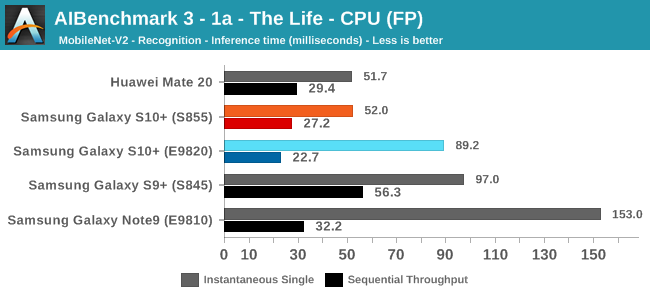
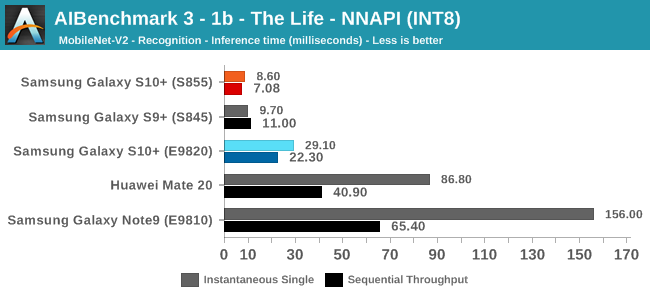
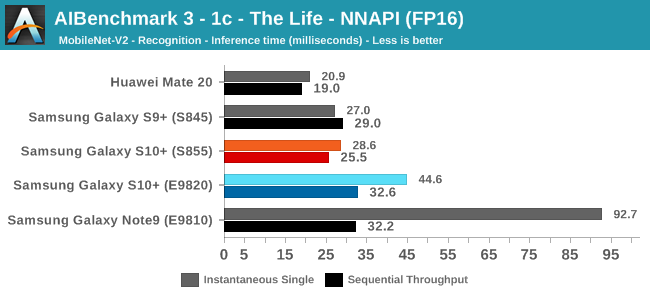

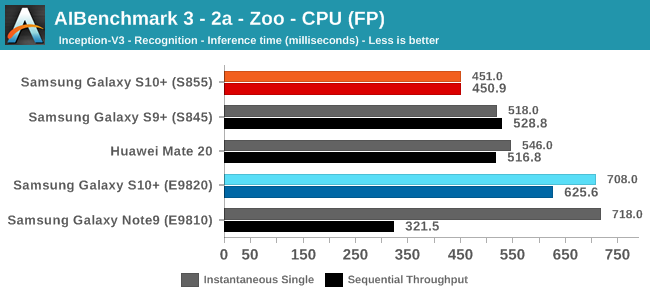
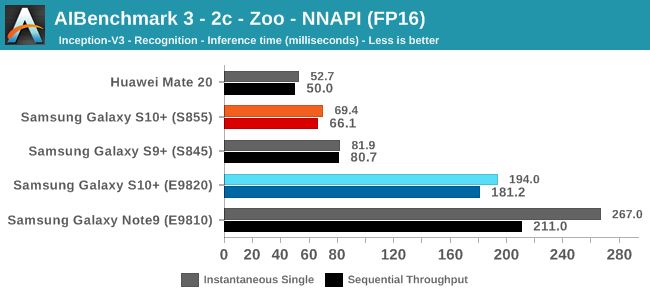
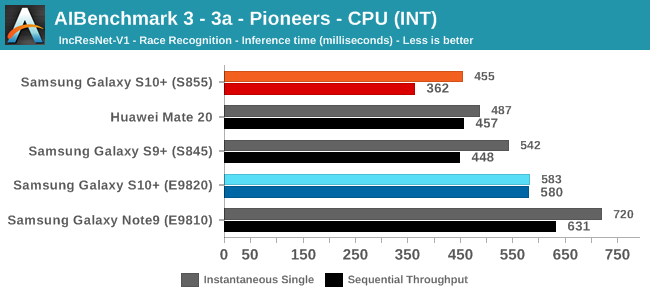
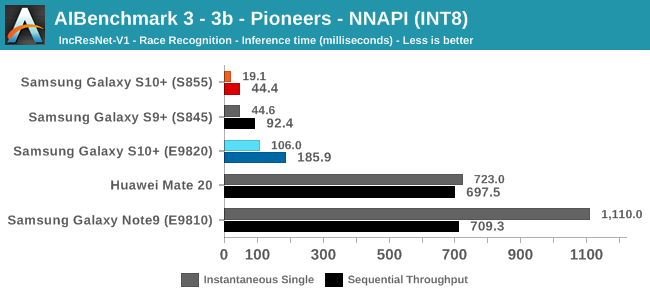
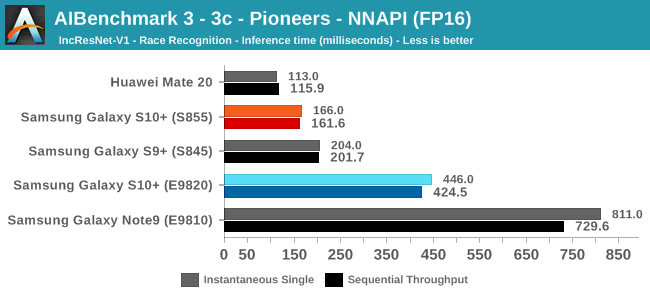

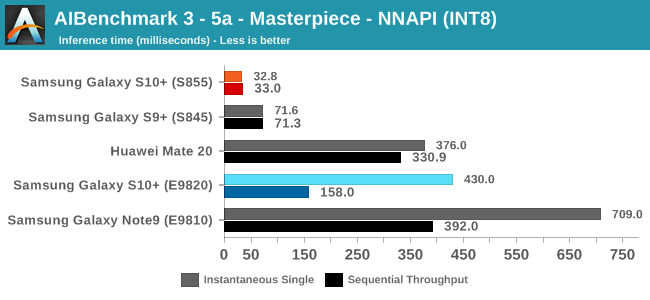
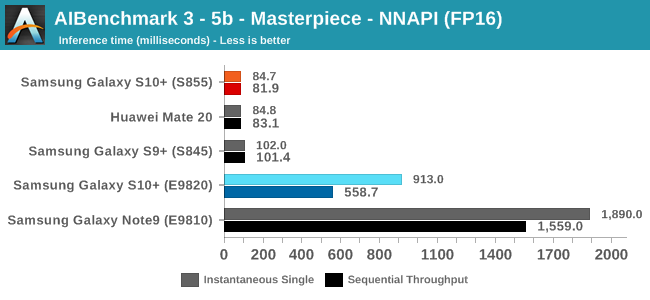
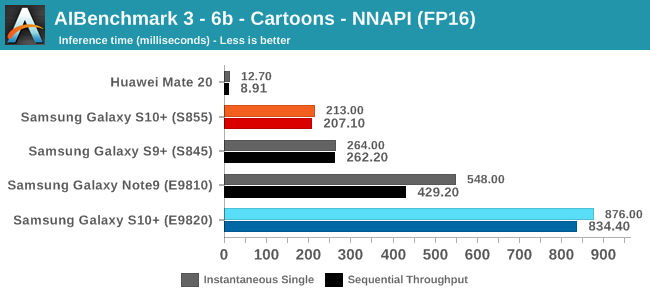






As initially predicted, the results are extremely spread across all the SoCs.
The new tests also include workloads that are solely using TensorFlow libraries on the CPU, so the results not only showcase NNAPI accelerator offloading but can also serve as a CPU benchmark.
In the CPU-only tests, we see the Snapdragon 855 and Exynos 9820 being in the lead, however there’s a notable difference between the two when it comes to their instantaneous vs sequential performance. The Snapdragon 855 is able to post significantly better single inference figures than the Exynos, although the latter catches up in longer duration workloads. Inherently this is a software characteristic difference between the two chips as although Samsung has improved scheduler responsiveness in the new chip, it still lags behind the Qualcomm variant.
In INT8 workloads there is no contest as Qualcomm is far ahead of the competition in NNAPI benchmarks simply due to the fact that they’re the only vendor being able to offload this to an actual accelerator. Samsung’s Exynos 9820 performance here actually has also drastically improved thanks to the new Mali G76’s new INT8 dot-product instructions. It’s odd that the same GPU in the Kirin 980 doesn’t show the same improvements, which could be due to not up-to-date Arm GPU NNAPI drives on the Mate 20.
The FP16 performance crown many times goes to the Kirin 980 NPU, but in some workloads it seems as if they fall back to the GPU, and in those cases Qualcomm’s GPU clearly has the lead.
Finally for FP32 workloads it’s again the Qualcomm GPU which takes an undisputed lead in performance.
Overall, machine inferencing performance today is an absolute mess. In all the chaos though Qualcomm seems to be the only SoC supplier that is able to deliver consistently good performance, and its software stack is clearly the best. Things will evolve over the coming months, and it will be interesting to see what Samsung will be able to achieve in regards to their custom SDK and NNAPI for the Exynos NPU, but much like Huawei’s Kirin NPU it’s all just marketing until we actually see the software deliver on the hardware capabilities, something which may take longer than the actual first year active lifespan of the new hardware.










229 Comments
View All Comments
nobodycalls - Friday, March 29, 2019 - link
WARNING:: With this new phone[ Samsung S10E and 10e. ] they no longer allow you to send or receive attachment photos and such on WiFi.. You have to turn on your mobile data! You cannot write long texts either.They say that is MMS not SMS and you must pay extra for that..We talked to multiple people at Xfinity and Samsung and most of them didn't even know about this new protocol on the OS. TOTAL RIP.. I am very upset about this and don't want this phone.. Not to mention the battery is weak...Thraxen - Friday, March 29, 2019 - link
I just sent a photo with mobile data off. So...?Irish910 - Saturday, March 30, 2019 - link
You can send (full quality) non downsampled pictures and videos over iMessage over iOS using WiFi. Even just a Bluetooth connection gives you airdrop to other iOS devices.Lau_Tech - Saturday, March 30, 2019 - link
Thanks for the hardwork and measurements Andrei! Sad to hear my exynos S10 isnt the equal of the snapdragon, although it remains the best option for me given what i have to choose from. I also suspect that Samsung will be doing what it can to mitigate the differences in camera performance through software updates. regardless, I am happy with my purchasetuxRoller - Saturday, March 30, 2019 - link
"Power efficiency here is better on the Snapdragon SoC by 15-18%."I'm getting 26-30% greater energy efficiency for the A55s Snapdragon. In lieu of capping the 9520's a55 to 1.78 wouldn't the better proxy be energy efficiency?
The_Quantum_Guy - Saturday, March 30, 2019 - link
Garry did a Speed Test-G on his channel pitting the Exynos 9820 in Galaxy S10e against the Kirin 980 in the Huawei P30, in it despite the Exynos having 2 extra Mali cores than the Kirin it still lost by about 3 seconds to the Kirin in the GPU test, and as expected it even lost in the CPU department. Scorng an overall 1:55 vs the Kirin's 1:44 and even behind last year's Snapdragon 845 (1:49). So how come is Exynos close to Snapdragon 855 (1:32) even this time around ?tuxRoller - Saturday, March 30, 2019 - link
Different tests stressing different thingsjospoortvliet - Saturday, March 30, 2019 - link
If you are talking those stupid app start tests - I neither see their relevance nor accuracy. They say nothing about device capabilities.The_Quantum_Guy - Sunday, March 31, 2019 - link
No I am not talking about the tests which tell you about the storage speed ( I dunno how you assumed that, as I have specifically stated the different times for GPU and CPU of different processors ). The test mentioned here tests different components of the processor one-by-one (that's what the guy doing it says and shows), and rather than providing numbers at the end he gives you times it took for a phone to complete each test (like a race). And going by those times the Exynos fared even worse than the last generation Snapdragon.Jhereck - Saturday, March 30, 2019 - link
Hi and thanks for this wonderfull and very complete article, the only one which compares SD and Exynos version of samsung's phones.Will the patch you are talking about in "system performance" which improves PELT responsiveness be included in future updates ?